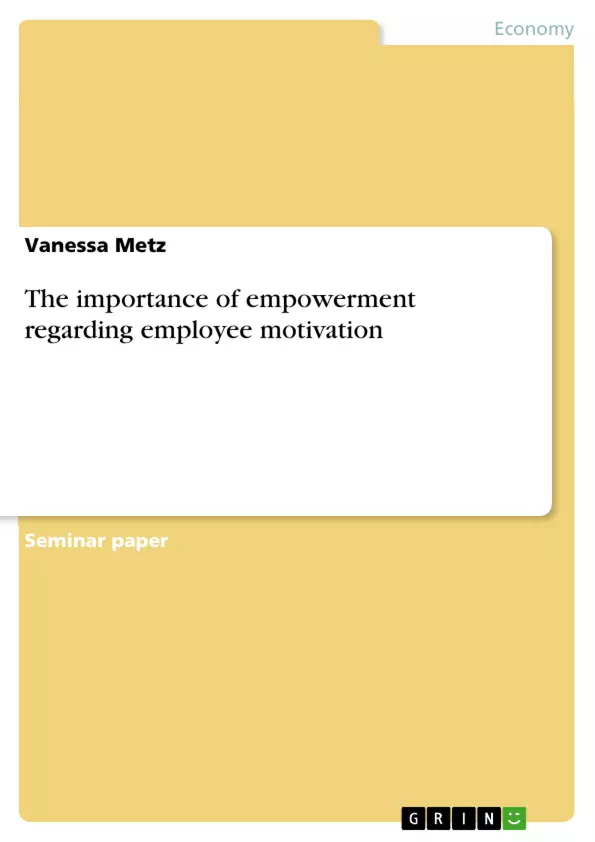This assignment deals with the importance of empowerment regarding employee motivation. Its about the opportunities for employees, leaders and organizations an empowerd employee can achieve. Employees who are empowered need a good leader. But not all workers can handle the responsibility and have to be encouraged differently. Likewise, not all managers can give up power and have to find another way to lead.
Table of Contents
- 1. Introduction
- 1.1 Problem
- 1.2 Objective and structure
- 2. Definition of the terms
- 2.1 Empowerment
- 2.2 Leadership
- 3. Employee motivation by empowerment
- 3.1 Empowering Leadership
- 3.2 Being an empowering leader
- 3.3 Increasing employee motivation by empowerment
- 3.4 Disadvantages of empowering leadership
- 4. Conclusion and outlook
Objectives and Key Themes
This assignment aims to explore the significance of employee empowerment in boosting motivation and to provide leaders with a concise strategy for motivating their teams. It delves into the concept of empowerment, its impact on employees, leaders, and organizations, and offers a deeper understanding of the interplay between empowerment and leadership.
- The definition and application of employee empowerment in a business context.
- The relationship between empowering leadership and employee motivation.
- Strategies for leaders to effectively empower employees.
- Potential drawbacks and challenges associated with empowering leadership.
- The evolution of empowerment from historical perspectives (Hawthorne Experiments).
Chapter Summaries
1. Introduction: This introductory chapter establishes the context of employee empowerment, highlighting its increasing relevance in the modern business world. It briefly touches upon the historical roots of the concept, referencing the Hawthorne Experiments and their contribution to understanding the impact of emotional factors on productivity. The chapter also introduces the central problem—the importance of empowerment for employee motivation—and outlines the assignment's objective and structure, setting the stage for a detailed exploration of the topic.
2. Definition of the terms: This chapter provides clear and concise definitions of the core concepts—empowerment and leadership—that are crucial for understanding the subsequent discussions. It defines empowerment as both a personal process of gaining freedom and control and as a management strategy to increase employee autonomy and participation. Similarly, it defines leadership in the business context, emphasizing its persuasive and visionary aspects beyond mere management.
3. Employee motivation by empowerment: This chapter explores the core relationship between empowerment and employee motivation. It examines various aspects of empowering leadership, offering insights into the qualities and actions that constitute effective empowering leadership. It further discusses practical strategies for increasing employee motivation through empowerment, while acknowledging and analyzing the potential disadvantages and challenges that may arise from such approaches. The chapter aims to provide a balanced perspective on the benefits and drawbacks of empowerment in the workplace.
Keywords
Employee empowerment, leadership, motivation, autonomy, responsibility, Hawthorne Experiments, job performance, job satisfaction, organizational commitment, challenges of empowerment.
Frequently Asked Questions: Employee Empowerment and Motivation
What is the main topic of this document?
This document explores the relationship between employee empowerment and motivation. It examines how empowering leadership can boost employee motivation and provides strategies for leaders to effectively empower their teams.
What are the key themes covered in this document?
Key themes include the definition and application of employee empowerment, the connection between empowering leadership and employee motivation, strategies for empowering employees, potential challenges of empowering leadership, and a historical perspective referencing the Hawthorne Experiments.
How is employee empowerment defined in this document?
Employee empowerment is defined as both a personal process of gaining freedom and control, and a management strategy designed to increase employee autonomy and participation in decision-making.
What is the role of leadership in employee empowerment?
The document emphasizes empowering leadership as crucial for effective employee empowerment. It highlights the qualities and actions of effective empowering leaders and explores strategies for leaders to foster empowerment within their teams.
What are some strategies for leaders to empower their employees?
The document doesn't explicitly list step-by-step strategies, but it implies that effective empowering leadership involves fostering autonomy, providing responsibility, and creating an environment where employees feel valued and trusted.
What are the potential drawbacks or challenges of empowering leadership?
While the document focuses on the benefits of empowerment, it acknowledges that potential drawbacks and challenges exist. These are not explicitly detailed, but are implied as areas needing consideration.
What is the significance of the Hawthorne Experiments in this context?
The Hawthorne Experiments are referenced as providing historical context to the understanding of how emotional factors, including a sense of empowerment, can influence employee productivity.
What are the chapter summaries provided in the document?
The document provides summaries for an introduction outlining the problem and objectives, a chapter defining key terms (empowerment and leadership), a core chapter on employee motivation through empowerment, and a concluding chapter.
What keywords are associated with this document?
Keywords include employee empowerment, leadership, motivation, autonomy, responsibility, Hawthorne Experiments, job performance, job satisfaction, organizational commitment, and challenges of empowerment.
What is the overall objective of this document?
The document aims to explore the significance of employee empowerment in boosting motivation and to provide leaders with a concise strategy for motivating their teams. It seeks to provide a deeper understanding of the interplay between empowerment and leadership.
Where can I find the table of contents?
The table of contents is included in the document and outlines the structure of the text, from the introduction to the conclusion.
- Quote paper
- Vanessa Metz (Author), 2020, The importance of empowerment regarding employee motivation, Munich, GRIN Verlag, https://www.grin.com/document/1021319



